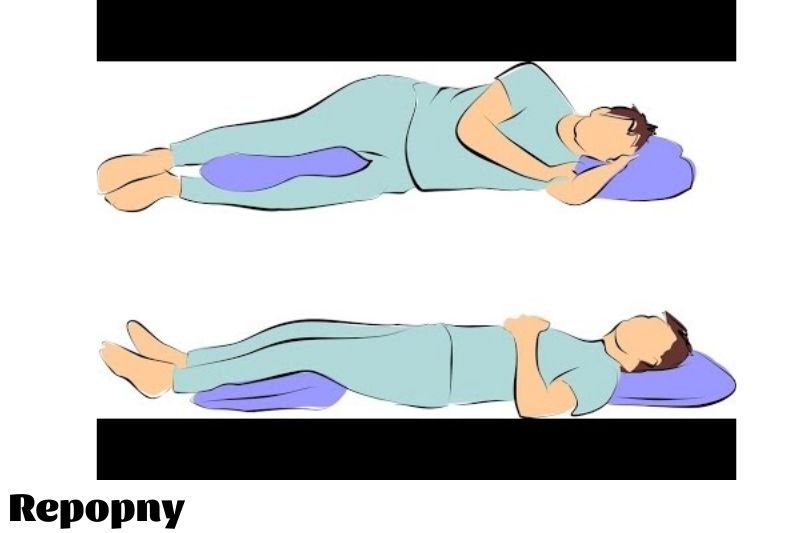- Repopny
If you suffer from sciatica, you know how debilitating the condition can be. The pain can make it challenging to get a good night’s sleep, exacerbating the problem.
However, Repopny will provide some things you can do to ease the pain and get a better night’s sleep. Here are some tips on how to sleep with sciatica.
Contents
- 1 What Is Sciatica?
- 2 First Step: Find Out Why You Have Sciatica Pain
- 3 Best Positions For Sleeping With Sciatica
- 4 Best Sleeping Posture For Pregnant Women With Sciatica
- 5 Avoid These Sleeping Positions If You Have Sciatica
- 6 Sleep Tips To Alleviate Sciatic Discomfort
- 7 How Can Lie In Bed Make Sciatic Nerve Discomfort Worse?
- 8 When Should You See A Doctor?
- 9 FAQs
- 10 Conclusion
What Is Sciatica?
Sciatica is nerve pain caused by a compressed, inflamed, or damaged sciatic nerve. The sciatic nerve originates in the pelvis and travels through the buttocks and down your leg to the knee. It links to other nerves that go down the leg and into the foot near the knee.
Lower back discomfort is not the same as sciatica. Lower back pain is a pain in a specific place of your back. If you have sciatica, though, you may notice:
- There is a sharp, searing, or shooting pain from the lower back to the foot.
- One or both legs or feet may have muscle weakness.
- One or both legs are numb.
- The sensation of pins and needles in the leg, foot, or toes.
Depending on which part of the nerve is damaged, the location of sciatica pain can vary. “Pain or tingling could be felt down the front, back, or side of your leg,” Sieberth explains. “The discomfort may be constant or occur when you sit or lie in particular positions.”
First Step: Find Out Why You Have Sciatica Pain
It takes some detective work to find relief from sciatica. First, try to figure out what’s causing the problem. After that, you can take action to remedy it. This may necessitate a visit to your doctor and some physical therapy sessions.
Sciatica can be caused by a variety of factors, including:
- Bulging or a slipped disk are both possibilities.
- The nerve that has been compressed or inflamed.
- Muscle tension in the back or hips.
- Vertebrae (spinal bones) that are out of alignment.
- Spinal stenosis is a condition that affects the spine (narrowing of the spine).
- A fall or an accident might cause damage to the sciatic nerve.
- There is a tumor or growth (in rare cases).
“What positions or activities hurt you depends on your sciatica,” Sieberth says. “This will also help you figure out which sleeping positions are best for you.” Back sleeping, for example, maybe more pleasant for someone with a bulging disc, but side sleeping may be more comfortable for someone with stenosis.”
Best Positions For Sleeping With Sciatica
Sciatica and other types of low back pain can make it challenging to get a good night’s sleep. According to studies, 55% of persons with chronic quieter back pain experience sleep difficulties.
Finding the ideal position for sciatica relief may take some trial and error. However, it’s good to stick to positions that keep your spine in its natural alignment as a general rule.
On Your Side
Sleeping on your side may help relieve the discomfort by reducing pressure on your inflamed nerve.
How to get started:
- Place your injured side on top of your mattress.
- If there’s a space between your waist and the mattress, a little pillow can help reduce side bending.
Between Your Knees, Place A Pillow
Keeping your pelvis and spine neutral might be as simple as putting a pillow between your knees. It also keeps your legs from turning in the middle of the night.
How to get started:
- Place your shoulder on your mattress first, then rest the rest of your body on it.
- Place a thin pillow between your knees and bend them gently.
- If there is a gap, a little pillow can be placed beneath your waist.
Position Of The Fetus
The fetal position allows space between your vertebrae to open up, which may help relieve back discomfort caused by a herniated disc. Some folks, however, discover that it aggravates their pain.
If the fetal position causes you pain, consider one of the other postures on this list.
How to get started:
- Lie on your side and raise your knees to your chest, forming a “C” with your body.
- A pillow between your legs or under your waist can also be used.
On Your Back With A Pillow Under Your Knees
Lying on your back allows your weight to be distributed evenly across your back. By relaxing your hip flexors, placing a large pillow under your knees can assist in maintaining the curvature of your spine.
How to get started:
- Lie on your back with a pillow under your head for further support.
- Place one or two cushions beneath your knees and lean comfortably against the mattress with your heels.
Underneath Your Lower Back, Use A Towel Or A Pillow
By decreasing the distance between your back and the mattress, placing a towel or small pillow under your lower back can assist keep your spine in a neutral position.
How to get started:
- Place a comfy pillow behind your head and lie face-up.
- Place a thin pillow or towel beneath your lower back to keep your pelvis neutral posture while you sleep.
- If you find it more comfortable, you can combine this approach with a pillow under your knees.
Sleeping On The Ground
Your spine may bend out of alignment as a result of soft surfaces. You might discover that sleeping on the floor helps you maintain appropriate spinal alignment.
How to get started:
- Place a thin mat on the floor where you plan to sleep, such as a yoga mat or a camping mat.
- Lie down in any postures listed above or in any other position that seems good to you.
Best Sleeping Posture For Pregnant Women With Sciatica
During pregnancy, doctors often advise sleeping on your side.
The ideal position for sleeping is on your left side, which is supposed to allow optimal blood flow through your inferior vena cava. However, according to studies, sleeping on your left or right side is equally safe for you and your kid.
If you have sciatica, you might discover that resting on your non-injured side helps alleviate your pain. Placing a pillow between your waist and the mattress or between your knees can also assist relieve pressure on your affected nerve.
Avoid These Sleeping Positions If You Have Sciatica
If you have sciatica or other forms of lower back pain, it’s typically recommended that you avoid sleeping on your stomach.
Your spine curves toward the mattress while you sleep on your stomach. If you sleep on a soft mattress, this curvature might strain your muscles and joints.
It’s good to avoid twisting your spine or hips when sleeping, no matter what position you’re in because this can pressure your sciatic nerve.
Sleep Tips To Alleviate Sciatic Discomfort
Here are some suggestions for dealing with sciatic discomfort during sleeping.
- Soft mattresses should be avoided. A too-soft mattress might lead your body to sink into it, causing your spine to become misaligned.
- A medium to firm mattress is a good choice. According to Trusted Source, mattresses that self-identify as medium-firm were shown to be the best for boosting sleep quality and spinal alignment. These are the finest mattresses topper for back pain.
- Plywood should be placed beneath your mattress. Try inserting a plywood board between your mattress and box spring if your mattress is too soft. You might also try sleeping on the floor with your mattress.
- Consider investing in a body pillow. A body pillow can help you avoid sleeping on your stomach or flipping from side to side in the middle of the night.
- Consider doing some yoga or stretching. Light stretching or yoga as part of your pre-bed routine might assist release your muscles and relieve nerve pressure.
- Take a long, hot bath. Some patients with lower back discomfort find that taking a warm bath helps them relax.
- Maintain decent sleeping habits. Good sleep habits, such as maintaining your room at a comfortable temperature, going to bed simultaneously every day, and avoiding coffee before bed, can all help you get a better night’s sleep.
How Can Lie In Bed Make Sciatic Nerve Discomfort Worse?
When persons with sciatica are in bed, they may discover that their symptoms worsen. Lying down might put more pressure on your injured nerve, mainly if you sleep on a soft mattress that encourages your spine to bend while you sleep.
When Should You See A Doctor?
If you’ve been experiencing sciatica pain for more than a week, you should see a doctor for an accurate diagnosis. They can assist you in determining the source of your sciatica pain and provide the best treatment alternatives.
FAQs
What relieves nighttime sciatica pain?
Here are some suggestions for dealing with sciatic discomfort during sleeping.
- Soft mattresses should be avoided.
- A medium to firm mattress is a good choice.
- Plywood should be placed beneath your mattress.
- Consider using a body pillow.
- Consider doing some yoga or stretching.
- Take a long, hot bath…
- Maintain decent sleeping habits.
How do you sleep when your sciatic nerve is inflamed?
Keep your heels and buttocks in contact with the bed and bend your knees towards the ceiling while lying flat on your back. For further support, place a pillow between your mattress and knees. Gradually add more pillows until you achieve a comfortable knee posture. It’s not unusual for people to have no alleviation after a few days.
Why does lying down make sciatica worse?
The weight of your body may apply pressure on your nerves in ways that it does not matter when you’re standing. Sciatica and other chronic pain caused by pinched or compressed nerves are particularly prone.
Video
Conclusion
If you suffer from sciatica, you know how painful and debilitating it can be. You may also be wondering if there is anything you can do to ease the pain and get a good night’s sleep. While there is no cure for sciatica, the above are some things you can try to ease the pain and get a better night’s sleep.




